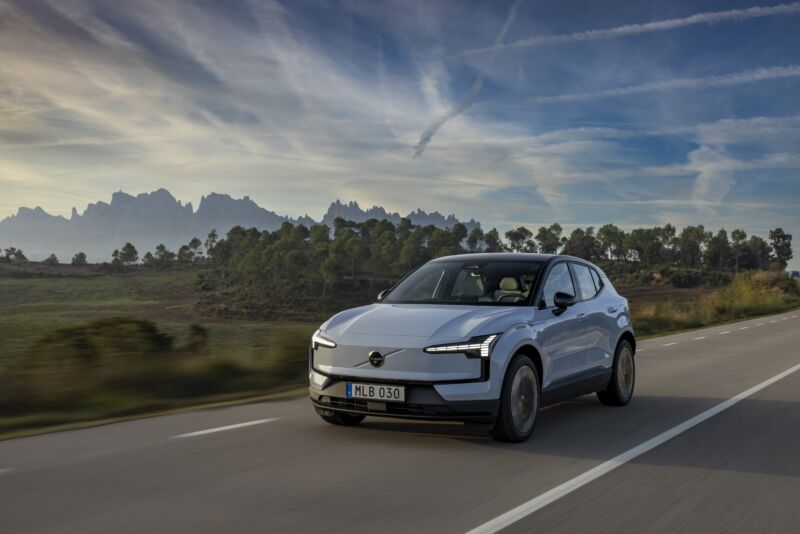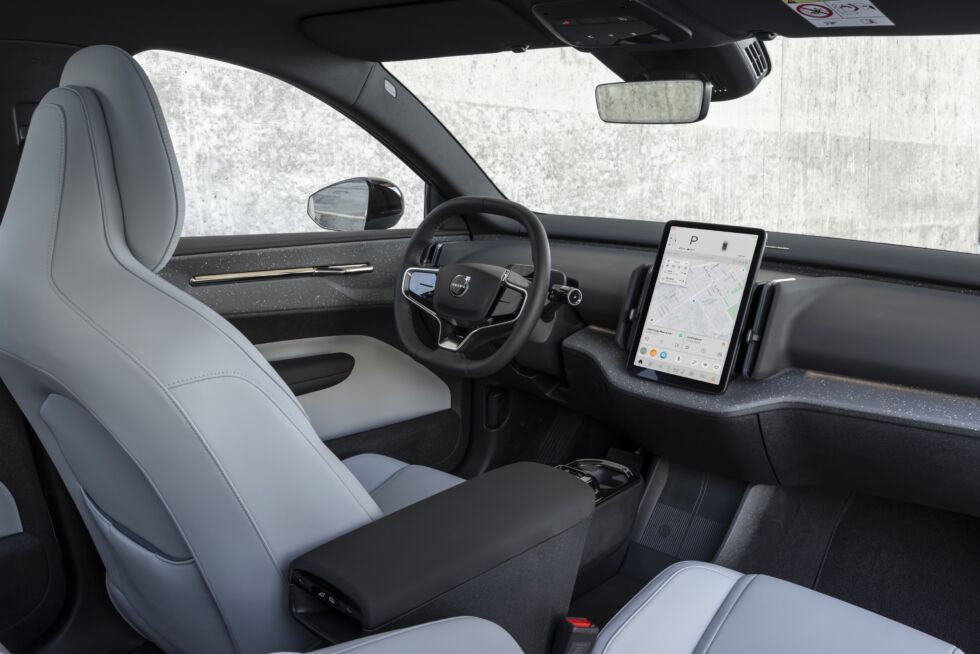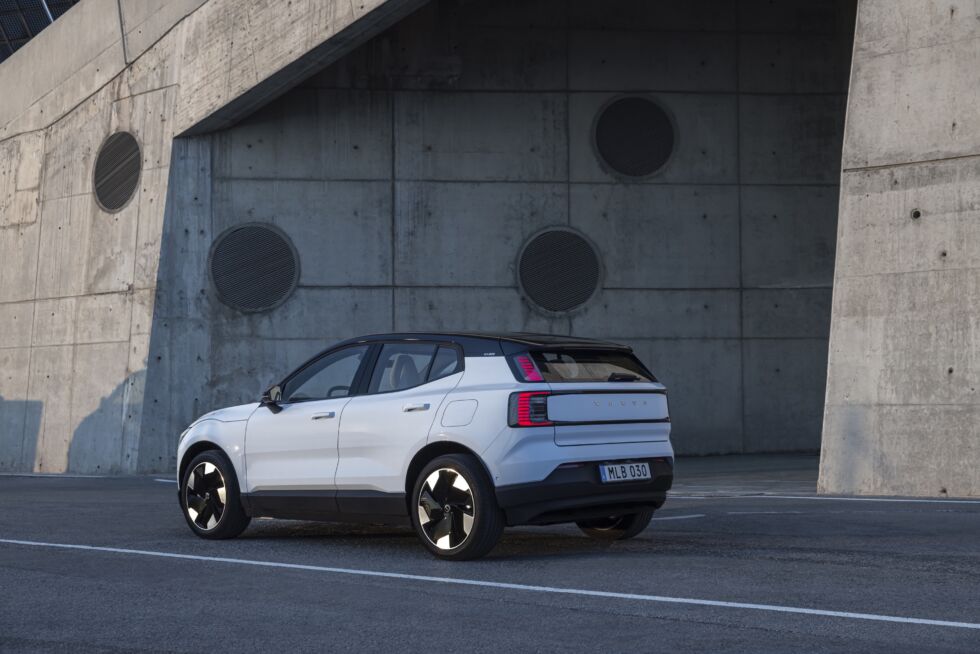
Volvo
Volvo’s near-term plan is to become a fully electric carmaker by the year 2030. But the company has an even more ambitious—and arguably more impactful—goal on the horizon: to be completely carbon-neutral by 2040. Volvo aims to achieve this by optimizing its manufacturing processes and greatly increasing the amount of recycled, sustainable materials being used in its cars. The new EX30 EV is a small crossover that represents a big step in this direction.
The EX30 focuses on carbon-neutrality from its inception. This subcompact electric SUV will be built at Volvo’s plant in Zhangjiakou, China—a facility powered by 100-percent climate-neutral electricity—and the carmaker will expand EX30 production to its Ghent, Belgium factory in 2025. Volvo estimates that 25 percent of the aluminum used in the construction of the EX30 is recycled, as is 17 percent of all steel. Additionally, 17 percent of all the plastics in the EX30—everything from bumpers to interior components—are recycled, which is the highest percentage of any Volvo to date.
Sitting inside the EX30, these efforts are on full display. Denim, flax and blended wool that contains 70-percent recycled polyester make up the deco pieces, which not only look cooler than traditional wood or metal trim, but feel more interesting beneath your fingertips. There’s a celestial deco that’s made from ground-down bits of scraps created during various manufacturing processes, and the denim pieces come from threading together shredded fibers that are usually wasted when recycling jeans. The flax fiber panels are colorful and full of texture, and vegan fabrics cover a long-time Volvo hallmark: super comfy seats.

Volvo
Further simplification comes from reducing the complexity of stamped parts. The two dash panels on either side of the 12.3-inch multimedia screen are identical, as are the air vents and arm rests, and two toggles housed on the center console serve dual-purpose as controls for the front and rear windows, which is an annoying byproduct of this focus on part reduction. Also, while it can be frustrating to have all of the car’s settings housed inside the touchscreen, this makes it so Volvo doesn’t have to manufacture superfluous buttons and knobs. Thankfully, the touchscreen quickly responds to inputs, and fixed rows of commonly used functions are always visible along the bottom of the display.
All told, Volvo says the EX30 represents a 25-percent reduction in carbon footprint compared to the company’s larger C40 and XC40 electric crossovers. Of course, much of this simply comes from the fact that the EX30 is a smaller vehicle, but make no mistake, this subcompact SUV can accommodate four adults in relative comfort with decent headroom, and if you fold the rear seats flat, there’s 31.9 cubic feet (903 L) of space to haul home, let’s say, crafty, upcycled yard sale must-haves.
Major gripes with this Volvo’s interior aren’t a product of the recycled materials, necessarily, but instead the need for cost-cutting in order to achieve the EX30’s bargain price. Large plastic panels below the arm rests on the doors feel chintzy, as do the slide-out cup holders and storage area below the center console. Still, it’s a necessary evil in order to hit a price point; the EX30 will start at $36,245 in the US, including a $1,295 destination charge, making it Volvo’s least-expensive car.

Volvo
The EX30’s fully electric—and emissions-free—powertrain is built around a 69-kWh battery with 64-kWh usable capacity. This pack can recharge at a maximum rate of 153 kW, which is good but not great, and Volvo will soon adopt Tesla’s North American Charging Standard plug, though not until 2025, meaning the first round of EX30s will be sold with an adapter to allow them to use Elon Musk’s Supercharger network.
In the US, Volvo will sell the rear-wheel-drive EX30 Single Motor Extended Range and an all-wheel-drive Twin Motor Performance model. The former relies on a single, rear-mounted drive unit with 268 hp (200 kW) and 253 lb-ft (343 Nm) of torque, while the latter adds a second, smaller electric motor to the front axle, bringing total output up to 421 hp (315 kW) and 400 lb-ft (542 Nm). Volvo claims a respectable 5.1-second 0-to-60 mph time for the standard version, but speed junkies will appreciate the Twin Motor’s 3.4-second launch time, which makes this variant the Swedish carmaker’s quickest production vehicle ever.
Final electric driving range specs will be finalized closer to the EX30’s arrival at Volvo dealers in a few months, but the company estimates 275 miles (442 km) for the single-motor SUV and 265 miles (426 km) for the AWD version. Both of those numbers best the EPA range of the EX30’s primary competitor, the electric Audi Q4 E-Tron.
-
This is a handy cartoon to show you your storage dimensions.
Volvo -
And an actual look at the rear cargo area
Volvo -
Volvo’s been using recycled materials for a while now and it’s gotten rather good with them.
Volvo
On crowded city streets winding country roads alike, the EX30 zips along with confidence. The ride is somewhat firm on the Twin Motor’s optional 20-inch wheels, and sticking with the smaller 18s or 19s definitely help with driving comfort. The steering is quick and well weighted, with a squircle wheel that’s enjoyable to handle. Strong regenerative braking allows for one-pedal driving if that’s your jam, but this can be turned off at the touch of a button for a more traditional coasting experience.
Given the fact that the Twin Motor only locks into all-wheel drive when you activate a Performance AWD drive mode, and that you’ll rarely (read: never) need to make use of that 3.4-second 0-to-60 time, the Single Motor EX30 seems like the best buy for most folks. That’s especially true when you consider that a fully kitted-out EX30 Single Motor Ultra—which comes with goodies like heated seats, a heated steering wheel, glass roof, adaptive cruise control, lane-keeping assist, Harman/Kardon stereo, automated parking assist and more—costs $41,895 including destination, while a less-loaded Twin Motor Plus starts at $46,195. The added power and punch really isn’t worth it.
The EX30 is an inexpensive EV, not a cheap one, and a reminder that Volvo’s been relying on recycled and sustainable materials for years to give its cars a premium edge that feels wholly Scandinavian. All of this bodes well for Volvo’s quest for a carbon-neutral future—and, in the near term, the EX30’s success.

